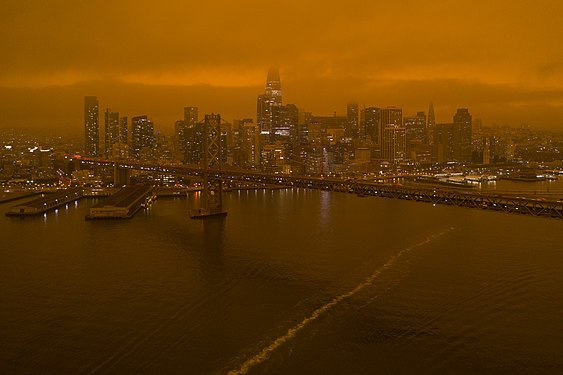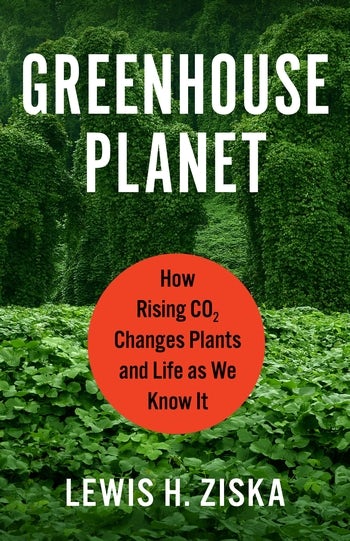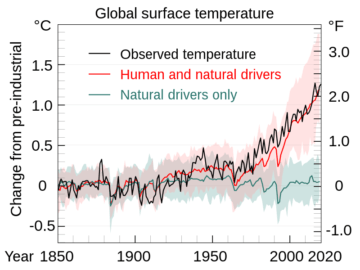by Paul Braterman

New Zealand is taking measures to reduce the amount of methane and nitrous oxide generated by the flatulence and urinations of its vast flocks of sheep and cattle. No joke; molecule for molecule, methane is about 80 times as effective a greenhouse gas as carbon dioxide, while nitrous oxide (laughing gas, an anaesthetic and euphoric) is 300 times as effective.
Such action, according to Ken Ham in Answers in Genesis on 17 October, is not a good idea. As always, the AiG arguments are a hodgepodge of standard denialist pseudoscience, repeatedly rebutted but endlessly recycled, to which I will return at the end of this article, together with a top dressing of biblical references forced into a libertarian straitjacket and mislabelled as religious, leading up to the final conclusion that action on greenhouse gas emissions is misdirected because
“The real problem facing New Zealand and the rest of the world isn’t an emissions problem—it’s our sin problem.”
On a whim, I decided to test this appraisal by collecting just those articles regarding climate change that happened to pop up in my newsfeeds, in the ten days immediately following AiG’s article, and the results are given below. Spoiler: emissions are repeatedly mentioned, but our sin problem is mysteriously absent.
The most dramatic news in that time was the implosion in the UK of Liz Truss’s government, and its replacement by a new team under her rival, Rishi Sunak. Jacob Rees-Mogg, Truss’s Secretary of State for Business, Energy and Industrial Strategy, was a fierce opponent of fossil fuel restraint, saying that the best way to get to net zero emissions by 2050 was to hurry up and burn up all the oil and gas before that date arrived. His replacement, Grant Shapps, while Transport Secretary in a previous government, had spoken of the need to reduce automobile use, which sounds hopeful, but as against that he has his own private plane, controversially registered in the US rather than the UK because that’s cheaper.

But back to the daily feeds. The day of Ham’s article, the US Department of Energy’s Pacific Northwest National Laboratory reported that the heat and aerosols generated by increasingly severe fires in the Western US were leading to more extreme weather in the central US as well. The same day, MarketWatch summarised an article in Nature Geoscience, showing accelerated melting of the Greenland ice sheet under the combined influence of warmer air and warmer water, while the Earth as a whole has been warming at an average decadal rate of 0.18oC since 1980, an acceleration of the warming trend of the previous century. As MarketWatch says, bad news for New York and San Francisco.

Bad news also, next day, for the glaciers in the Swiss Alps, which in the summer of 2022 shrank by an unprecedented 6.2%. There is positive feedback involved here, since as glaciers shrink the sunlight that they would have reflected is absorbed by newly exposed soil, and warms the air in the valley. In 2022, for the first time ever, Zermatt had to close its summer skiing, while Mont Blanc was closed to mountaineers because the permafrost that holds the rocks together had melted, making the terrain unstable. Things aren’t looking too good for the Himalaya glaciers either, according to Yale University’s School of the Environment. Here a long term melting trend has accelerated in recent decades. Meltwater from these glaciers feeds the Indus, Ganges, and Brahmaputra river systems, and in the very short run greater melting with increased their flow, but as soon as 2050 this is expected to decline, with serious implications for the 1 billion people who rely on those rivers for summer water. I wonder whether the great rivers of China are similarly vulnerable to warming on the north side of the Himalaya and the Tibetan plateau.
The oceans also are warming faster than ever, according to Nature Reviews on 18 October, and continued warming is now inevitable until the end of the century, although its extent depends on how successful we are in reducing emissions.

Warming oceans may have very dramatic effects on ecosystems, since higher temperatures mean less dissolved oxygen. There is a good reason why so many productive fisheries are in the cold waters of the northern Atlantic. According to the Seattle Times and The Guardian, we may already be experiencing the effects of warming, in the massive collapse of the Alaska snow crab fishery.
Overall, the oceans play a central role in maintaining this planet’s habitability, with CO2 uptake and oxygen release from phytoplankton. (Incidentally, it belatedly occurs to me that yet another absurdity of the so-called biblical climatology that I discussed in my last article here is that the ocean temperatures required would have cooked all the fish.)
While international action is notoriously difficult to achieve, the Montréal Protocol shows what can be done if the political will is there. As Eos, the American Geophysical Union’s newsletter, pointed out on 18 October, this Protocol, originally directed against ozone-destroying chlorofluorocarbon refrigerants, has now been extended to a far wider range of other substances that act as greenhouse gases. In a rare display of cross-party unity, the U.S. Senate agreed last month to ratify the protocol’s most recent extension (known as the Kigali Amendment), and on this basis, as the Washington Post wrote on 20 October, the US Environmental Protection Agency has already announced plans to cut back further on the production and use of hydrofluorocarbon refrigerants, which are among the worst offenders.
One further possible consequence of warming is increased risk of spillover of viruses, as discussed on 19 October in a paper in Proceedings of the Royal Society, examining how viruses and their hosts co-evolve under changing conditions in an Arctic Lake. There is no suggestion that spillover is particularly likely, but should it occur, we now know all too well that the consequences could be extremely serious.
 Also on 19 October, Popular Science book reviews covered Greenhouse Planet by Columbia University’s Lewis Ziska, which warns that the effects of added carbon dioxide on plant growth are mixed and largely unexplored, while it is known that warming may reduce grain yields, by disrupting the normal thermal signatures for budding. (For more on this theme, from Eos, on October 21, see here.)
Also on 19 October, Popular Science book reviews covered Greenhouse Planet by Columbia University’s Lewis Ziska, which warns that the effects of added carbon dioxide on plant growth are mixed and largely unexplored, while it is known that warming may reduce grain yields, by disrupting the normal thermal signatures for budding. (For more on this theme, from Eos, on October 21, see here.)
On the same date, ABC News reported that the 22-year drought originally affecting the American West is now also affecting riverbeds and bodies of water all over North America, with similar effects reported in Iraq, Europe, and China. Earlier (Reuters, October 18) UNICEF had reminded us that famine in Somalia is now acute. There are in fact now some 22 million people at risk of famine in the Horn of Africa, where the rains are now expected to fail for the sixth consecutive year; for more on this see here.
And, still on October 19, Angel Hsu, an environmental scientist who founded and heads the Data-Driven EnviroLab at the University of North Carolina at Chapel Hill, explained to Knowable Magazine that direct heating effects are worst in cities, with heat reflection from roads and walls, and hot exhaust from traffic, giving a typical urban heat-island effect of 3 – 4oC, but up to 10oC in the worst effected neighbourhoods. Air conditioning adds directly to heat in the streets, by pumping it out of buildings, while of course the contribution of fossil fuels to generating the power required adds to heating on a global scale.
The Atlantic published a series of dramatic images showing the drought-shrunken Mississippi, with stranded barges, and foot access to the island of Tower Rock
On October 23, Prof Dame Jenny Harries, the chief executive of the UK Health Security Agency, told the Guardian that the climate crisis poses a growing threat to health in the UK, with the benefit brought by milder winters being counteracted by the effects of flooding, food insecurity, and mosquito-borne diseases, and as well as the direct effects of extreme heat such as that experienced by the UK this summer.
As of October 25, the emperor penguin is officially at risk of extinction, as a result of melting sea ice.
But there was some good news that day; the New York Times reported that more than 80% of new electrical generating capacity in 2021 came from renewables, with solar leading the way. However, fossil fuels still supply over two thirds of generating capacity, while the carbon-free sector has been further damaged by the retiral of nuclear power stations.
On the last day covered by this article (October 26) we had a report that methane emissions are rising faster than ever. Carbon isotope studies1 suggest that this methane comes from agriculture or wetlands, which could be very bad news indeed, since if warming wetlands are emitting more methane, this will be yet another positive feedback process.
And on the same day, the United Nations annual assessment warned us that countries around the world are failing to live up to their commitments to fight climate change, pointing Earth toward a future marked by more intense flooding, wildfires, drought, heat waves and species extinction. The stated target of limiting overall warming to 1.5oC will not be met, unless there is dramatic change, and we are heading for 2.4oC (for perspective, 1.2oC is where we are right now). The New York Times gave us a major review of the overall situation, where hopeful signs include the belated emergence of climate as a major political issue, and the softening from climate change activists of their opposition to nuclear and carbon capture technologies. Politically, as I write, the signs are mixed. Bolsonaro’s project of destroying the Brazilian Amazon has been paused by electoral defeat. The UK’s latest prime minister had initially chosen to absent himself from the COP27 conference, until forced by wide-spread criticism to reverse this decision, while the looming US midterms seem likely to drastically limit President Biden’s ability to take action.
The role and public perception of fossil fuel companies was the subject of several reports. The Pulitzer-winning Inside Climate News described (October 24) how these companies are selling off assets to private equity, where use policy will not be the subject of inconvenient shareholder questions or news reports. The State of New Jersey filed suit on October 18 (see here) against ExxonMobil, Shell Oil Company, Chevron, BP, ConocoPhillips, and the American Petroleum Institute, claiming decades of concealment and deception on climate change, with internal memos showing that increased bad weather and even the current wave of public reaction had been foreseen decades ago.
An easy and effective way to draw attention to the climate emergency is to throw soup over van Gogh’s sunflowers (don’t worry; we all know that the painting is behind glass), and on October 20 Colin Davis, who holds a Chair of Cognitive Psychology at Bristol, presented evidence that such measures have probably helped raise public awareness of the issue (Professor Davis has himself been arrested for similar activity).
Also on October 20, we learned that a mysterious body calling itself the Climate Change Forum, motto “Global Investment in Sustainable Development” (there are genuine bodies with similar names, e.g. here, here) gave a platform to Marc Morano (who thinks that climate scientists should be publicly flogged and that both climate polices and Covid lockdowns are part of the same evil conspiracy) and Christopher Monckton, long-time climate change denialist, who at the conference praised coal and called global warming concern a religion. Graham Stuart, UK Minister of State for climate in the short-lived Truss government and in its successor, had the good sense to pull out when he saw their names on the programme.

Stuart did however appear by video link at the Carbon Capture and Storage Association (CCSA)’s annual conference (October 18 – 19). Drax, which had been scheduled to sponsor this conference, quietly dropped that role, with detractors claiming (October 19) that it was doing so after bad publicity. Drax supplies 6% of the UK’s energy by burning wood pellets, which it claims is an essentially carbon neutral process, because of treeplanting, although the wood in question comes from felling trees in old growth forests in British Columbia and needs to travel 11,000 miles. Drax is also seeking support for its own carbon capture and storage project, which would make the process strongly carbon negative. For what it’s worth, I regard carbon capture and storage as an unproven and uncertain technology, although Bill Gates takes it seriously, and he knows rather more about emergent technologies than I do.
As it happens, Bill Gates’s annual climate memo came out during my chosen time window, on October 18. It is, as you would expect, businesslike, and I will not attempt to summarise its 2500 words, but note the following points:
Progress towards net zero has been faster than at one time seemed possible, but we are still a long way from limiting climate change to 1.5oC or even 2oC. There seems little hope of cutting down total energy requirements, nor is it morally acceptable to attempt this at a time when so much of the world is still emerging from extreme poverty. So our hope must lie in technologies that use energy more efficiently, or raise it from more nearly carbon-neutral sources. We have the examples of the emergence of solar and wind-based power generation, and of lithium-based storage. Private venture capital is exploring possibilities such as storing energy thermally in melted salts, and developing air/iron batteries. Governments are paying at least lip service to net zero targets, although progress here has been greatly disrupted by the effects of the war in Ukraine. Gates mentions expansion of the use of renewables, and also of the prospect of carbon capture and storage, although I am rather surprised that he does not mention small modular nuclear reactors or any other form of nuclear energy. He also mentions agricultural improvements, which reminded me of the almost untapped potential of genetically modified organisms (see e.g. here and here). Gates describes climate change as the greatest challenge has ever faced humanity (though I would regard as the Ice Ages, and the Black Death, as close competitors), and his wide-ranging discussion concludes with the words “We have already achieved many energy breakthroughs. We need to achieve more, faster, to avoid a climate disaster.”
With all this background, we can return to the Answers in Genesis arguments that triggered my listmaking. Here they are in full:
While the fact that the climate is changing is observational science, climate models (trying to predict the future) are highly susceptible to the parameters used in the models. That’s why different scientists get different results and therefore make different (and, so far, wildly inaccurate) predictions.
False. Climate models, even going back 50 years, have proved remarkably good. The major uncertainties are not within the climate models themselves, but within the expectations of human activity. If the outlook is less frightening than it seemed 20 years ago, that is because we have already done some small part of what we need to do, with the phasing out of coal and the upsurge in renewables.
Most, if not all, of the doomsday predictions by climate change alarmists haven’t come true.
See previous paragraph. As Maarten Boudry tweeted back in January,
First signs of a new “self-defeating prophecy” emerging: we’re no longer on track for the worst warming scenarios, mostly thanks to the switch away from coal (in turn thanks to warnings by science). Cue climate sceptics: “See, we told you you overreacted!”
Instead the goal posts just keep moving and the hand wringing continues. For example, in the 1970’s the concern was global cooling, then it became global warming
No; see here and, from the American Meteorological Society, here. Even in the 1970s, most climatologists regarded warming as more likely, with outliers such as Hubert Lamb, founder of the Climate Research Unit at the University of East Anglia, pivoting towards predicting warming in the mid-1970s.
and now, with no significant warming or cooling in 15 years

False. See above Figure
The claim that there has been no warming for 15 years is a leftover from a decade-old cherry picking exercise, and is based on drawing a straight line from the local peak of 1998 to the local valley of 2012, since when every single year has clearly been warmer than 1998.
…the concern is now more extreme weather patterns.
There is indeed concern about more extreme weather patterns, and so there should be. As documented by World Weather Attribution, a partnership of Imperial College London, the Royal Netherlands Meteorological Institute, and Red Cross-Red Crescent, global warming has greatly increased the probability of such events as droughts, the extensive flooding that has so badly affected South Asia, and extreme heat waves like that experienced by Europe this summer.
Climate is incredibly complex, and scientists don’t fully understand it yet.
True, like so many things. So what? We don’t fully understand cancer. Does that mean it’s okay to take up smoking?
What you believe about the age of the earth will determine much of what you believe about past climates and the amount of warming in the recent past.
Up to a point. If you’re capable of ignoring the evidence for an ancient Earth, you’re obviously capable of ignoring a great deal, and specifically the evidence from hundreds of thousands of annual layers in ice cores and sediments, which, as I discussed in my last article here, have contributed to our understanding of climate. But the brute facts of warming, the scientific theory of greenhouse gases, and the inevitable amplification by secondary effects do not depend on the study of the distant past.
Greenhouse gases, like carbon dioxide and methane (especially methane), make up a very small percentage of the warming effect (water vapor and clouds have a much bigger effect) so the docile cows and sheep in New Zealand really aren’t doing anything to destroy the earth.
The focus here on methane is interesting, and ties in with the links between creationist, fossil fuel defending, and right-wing political organisations in general. It is grotesque that at the same time that creationist organisations deny the existence of amplification effects, they point to the greenhouse influence of water vapour. This is one of its main agents of amplification, as oceans warmed by the direct CO2 greenhouse effect inevitably feed more water vapour into the atmosphere.
Indeed, it may be that this increase in carbon dioxide is actually leading to a greener planet, with more food available for everyone.
Not so simple. There is indeed evidence of added carbon dioxide spurring overall plant growth. However, two recent reports (see above) mentioned the prospect of crops being damaged by warmer winters, and it seems that it is far too simple to consider CO2 as a limiting nutrient, while in addition increased temperature as such tends to make photosynthesis less efficient, and this is before we even consider the effects of floods and droughts on agriculture.
Climate has changed in the past—including warming before we began burning fossil fuels at today’s rates.
True. It did change. But not at today’s rates. What follows?

And finally, the inevitable God has promised that humans won’t destroy the earth (Genesis 8:22)!
But I fear that doesn’t actually promise very much. “While the earth remains, seedtime and harvest, cold and heat, summer and winter, day and night, shall not cease.” No guarantee of adequate harvests, and Genesis tells us of repeated famines affecting the lives of the Patriarchs, eventually forcing Jacob and his family down into Egypt as climate refugees. Nor is there any other protection from the consequences of our folly, short of total devastation. As so often, what Genesis says, and what creationist organisations say that Genesis says, are very different things. (While I was writing this, Bill Trollinger at Dayton made the same point about this verse elsewhere.)
In conclusion, I owe my readers here in an apology. My very first article for 3 Quarks Daily was a critique of creationism, but it has taken me until very recently to wake up to its broader agenda, and specifically its political connections, while as Carl Weinberg’s Red Dynamite convincingly shows, and as careful reading of Ronald L. Numbers’ classic study The Creationists should long since have alerted me, those connections have been present in modern Young Earth creationism from the beginning.
1] These are stable isotope studies (13C/12C), depending on chemical fractionation, not to be confused with dating studies that involve the unstable isotope 14C.
